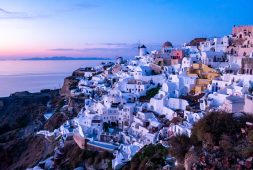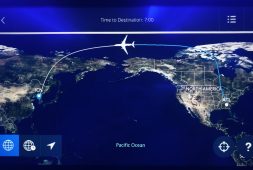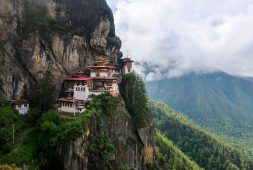
World class diving. Orangutans in their natural habitat. Rainforest and jungle trekking. All reasons to visit Eastern Malaysia on the island of Borneo. Borneo is the third-largest island in the world and the largest in Asia. Politically, the island is divided among three countries: Malaysia, Indonesia, and Brunei. And is home to one of the oldest rainforests in the world. I was on my way to the Philippines from Bali and made a stop through Borneo in Malaysia. This article shares the highlights of my journey.
BORNEO TRAVEL WARNINGS
Of course, doing any research on the island, you will inevitably come across news on travel warnings for tourists. Especially traveling to the beautiful diving sites like Sipadan off the east coast of the Malaysian province of Sabah. There are stories of tourists being kidnapped while on a boat heading to their diving resort. The kidnappers were locals trying to make a statement to the tourism industry to leave their home islands alone. And in one incident not so long ago (2014), a policeman was shot and killed on Mabul Island. But since then, the government has invested to protect these tourist routes out on the water.
LOGICALLY, MABUL ISLAND WAS MY FIRST STOP
If you dive, you will know this area is high up in the world’s top diving site lists. It was my first diving experience since my open water certification and the primary reason why I came to Borneo.
The diving around Mabul Island was certainly incredible. Sea walls teeming with fish around stunning corals built into the wall. Turtles bigger than me. And triggerfish.
TRIGGERFISH ATTACK
Normally triggerfish are not dangerous. But they can be very dangerous if disturbed while protecting their nest. And during one of our dives (two divers and a dive master), my German friend accidentally backed into a triggerfish nest which upset the decent-sized fish about the size of football. Before entering the water, we learned that this fish bites. And it started going after my fellow diver. Our dive master joined the diver as the fish would swim up and try to bite them.
The dive master kicked at the fish as it came at him. The first would swim away and the circle back to try to attack again. The dive master kept kicking at it. This happened for about five minutes until the underwater current carried us away from the nest and the fish swam away. But it was really scary at first. I was about five meters away watching the entire encounter with excellent underwater visibility. After several minutes I realized the fish wouldn’t reach them and I became more relaxed. This would ultimately be my favorite dive of six dives over two days. Beautiful fish, sea walls, a nice current to take us floating along the wall, and of course a fun fish attack. A great memory and something to laugh about as we surfaced.
SIPADAN TOP 5 DIVING SITE IN THE WORLD
Unfortunately I did not have my Advanced Open Water Diving certification yet and I wanted to practice my breathing and buoyancy underwater before diving deeper. The only way to go to Sipadan Island is to have your Advanced certification because it has currents and is very deep. Sipadan has been rated one of the world’s top diving sites. I was a little bummed about not diving it but I was thrilled to get more practice in this highly touted diving region.
I dove with Scuba Junkie and would highly recommend this company for their professionalism and overall safety measures. And their resort on Mabul Island is extremely nice. Even the dorm rooms are excellent!
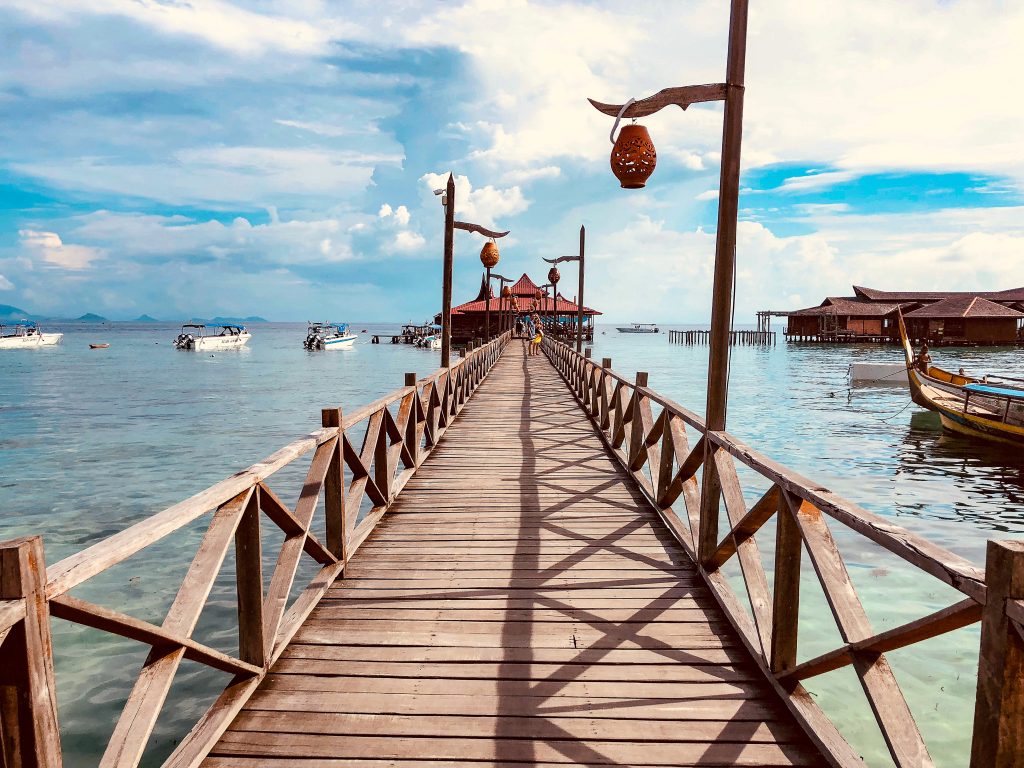
Tip: if you are visiting this area, don’t spend much time in Semporna unless you have to. It’s a very dirty port town that you must travel through to get to the diving sites.
INTO THE JUNGLE
After diving, I took a bus from Semporna to the small town of Kinabatangan for $12 USD (45 ringgit). I would recommend the Manis Liner because it only has three seats across and is very comfortable. Just wear pants and bring a long sleeve shirt since the aircon works very well.
After the four hour bus ride, the bus dropped me off at this tiny village along the roadside. I had to wait a couple hours at this outdoor café called the “Meeting Point” before the tour company picked me up to take me into the jungle. I joined other tourists who came from a different village. We all embarked on a three day, two night jungle safari.
About an hour and a half later, we arrived in the small village, Bilit, deep in the jungle along the Kinabatangan River. The Nature Lodge Kinabatangan, was on the opposite side of the river so we loaded our bags into a small boat and hopped in for the short boat ride.
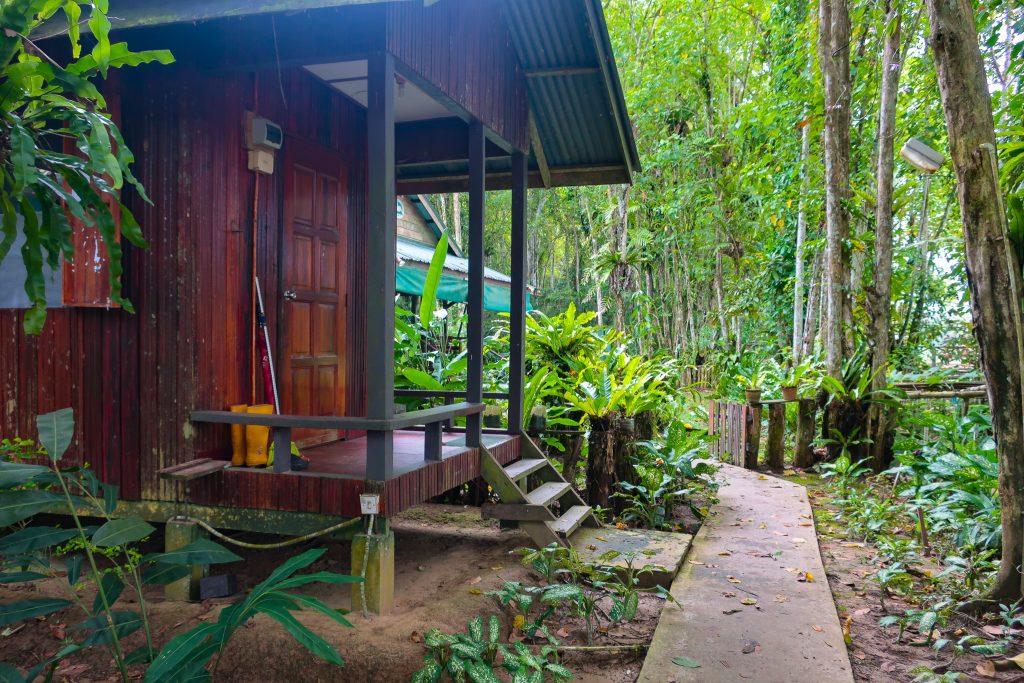
NOT YOUR TYPICAL RIVER CRUISE
The Kinabatangan River is the second longest river in Malaysia. The muddy brown river is lined on both sides by lush jungle vegetation including large trees where many species of monkeys sleep at night for protection. During our multiple river cruises (one at sunrise and one at sunset), we would spot many monkeys feeding up in the trees as they prepared to sleep at dusk as well as prepare to go deeper into the jungle at sunrise when they woke up.
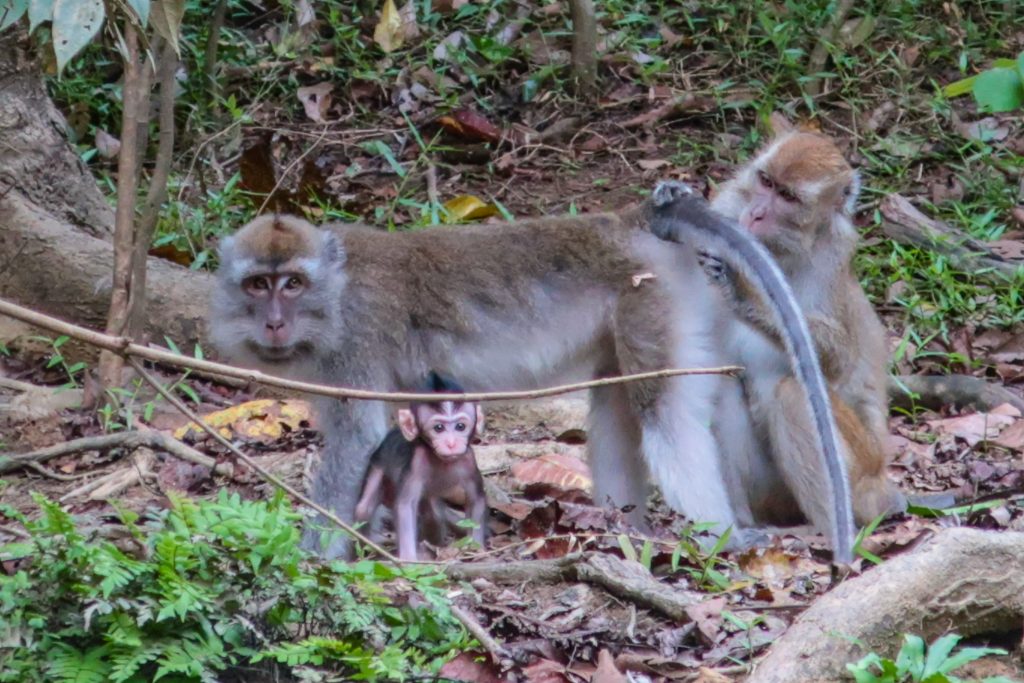
And one of the most special sightings were three different orangutans making their evening nest high up in the trees along the river. Unlike monkeys that travel in packs, orangutans travel alone their entire lives. Because they don’t have the protection of other monkeys combined with their natural habitat being taken away from the expansion of palm oil tree plantations, the orangutans are quickly becoming extinct. It is rare to see orangutans in their natural environment and it was beautiful to see with my own eyes.
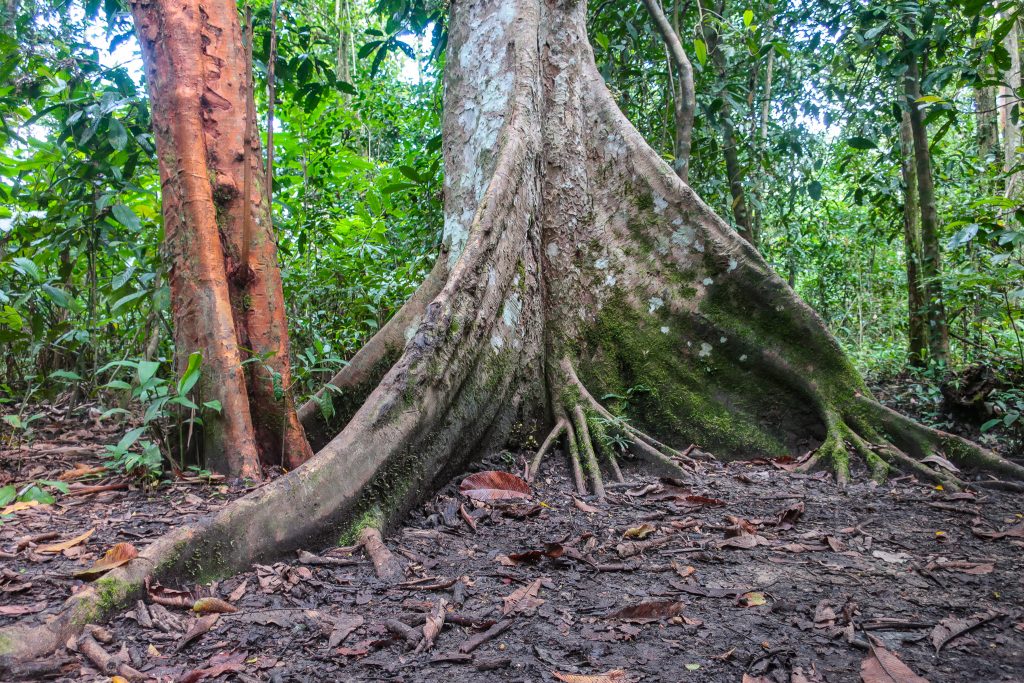
In addition to all the monkeys we saw, we also saw poisonous snakes ten feet up in the trees sleeping as well as several eagles flying overhead. One evening our guide spotted an owl perched up on a tree. On the sunrise cruises, we saw huge, 12-foot crocodiles resting along the muddy riverbank after a very active night of hunting. We would also see some smaller crocodiles floating in the water.
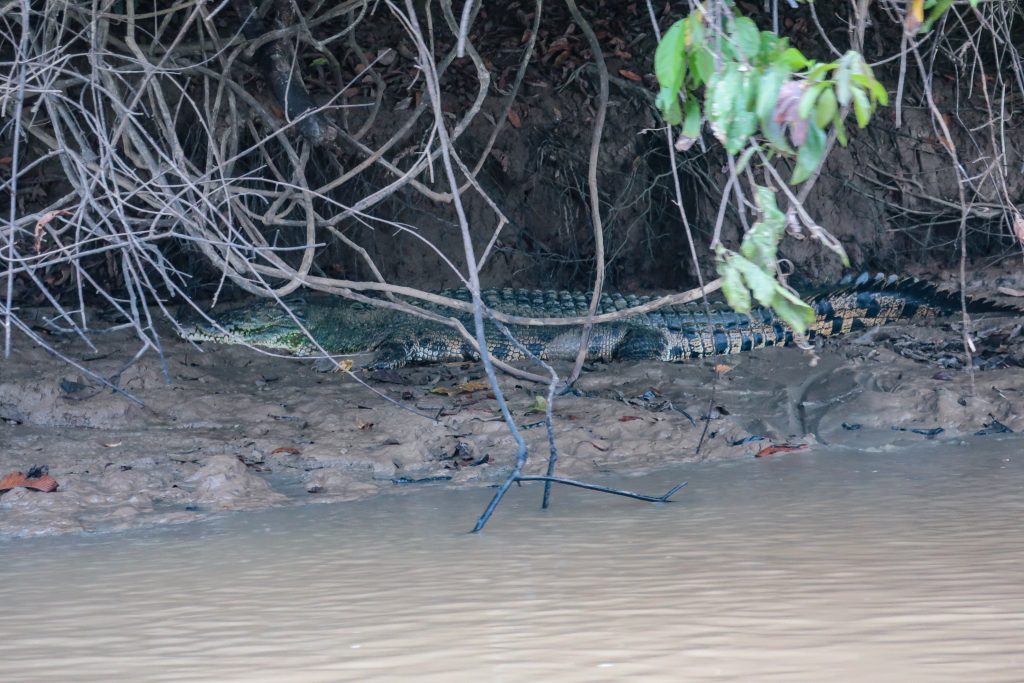
JUMPING LEECHES??
We also took jungle walks – one during the day and one at night to see smaller inhabitants of the rainforest. The lodge gave us mud boots and we had to tuck in all of our clothing since skinny leeches about three to four inches long lived on the plants we would brush up against. If any skin was exposed, the leeches would certainly find bare skin. We would see the leeches leap up at one end toward us as we passed hoping to latch on to. And the ground was extremely muddy since it rains very often in the rainforest. Imagine trudging through sloppy mud with extreme humidity combined with very hot temperatures wearing long layers of clothing passing by wet plants full of jumping leeches! Ah yes: what fun in the jungle!
SAFE PLACE FOR THE ORANGUTANS
After three days in the jungle, I was transferred about two hours to Sepilok to see the Orangutan Rehabilitation Centre where they are trying to protect the endangered species. They have set up a protected area for the large monkey species to roam and not have to worry about their habitat being taken away. They also have an orangutan nursery to raise the newborns safely.
It was interesting watching the brown creatures as their mannerisms mirrored those of a species we know all too well: humans. It began to rain and all the orangutans would hold their hands over their head since they didn’t like the rain. And they would try to find shelter until the rain stopped. As they walked, they looked like small, furry humans!
Away from the nursery, they had a feeding platform where the animals were supposed to come for scheduled feeding times. All of the tourists would show up to this spot in the protected area. After about twenty minutes of waiting with food laid out on the platform, it was clear the orangutans would not show up, probably because it was raining. They were all at the nursery where I just had visited and weren’t going to come to the feeding platform. Glad I went to the nursery first.
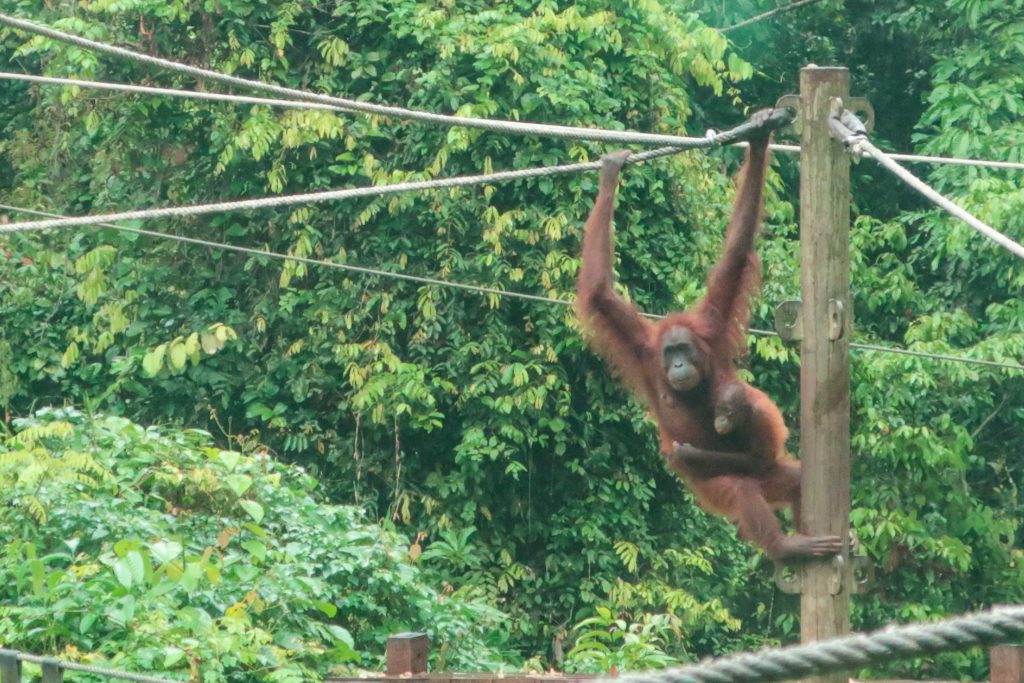
ONWARD TO THE NEXT DESTINATION
Kota Kinabalu (KK) is the main city in Sabah, eastern Borneo. Most flights come through KK. I had planned to travel from Sandakan (near Sepilok) to KK via a six hour bus ride, however heard the flight between the two cities was only $20 more than the bus. It was an easy decision to spend a little more to take the 30 minute flight.
My next destination is the Philippines and there is a nonstop two hour flight from KK to Manila that I decided to take. I was unable to spend any time in KK but I heard it’s a nice, artsy, up and coming city. Plus if you want to climb Mount Kinabalu, you most likely will start from the city.
Overall, the diving was the highlight of my visit to Borneo. And it was worth the stop. I would highly recommend diving off the coast of Semporna (Mabul and Sipadan). If you have extra time and want to see monkeys and orangutans in the jungle, then certainly visit the Kinabatangan River region. However I wouldn’t give it five stars. Maybe three at best. It was interesting but I wouldn’t go back.
Have you been to Borneo? What was your favorite spot? Feel free to share your thoughts below in the comments to help other travelers.
